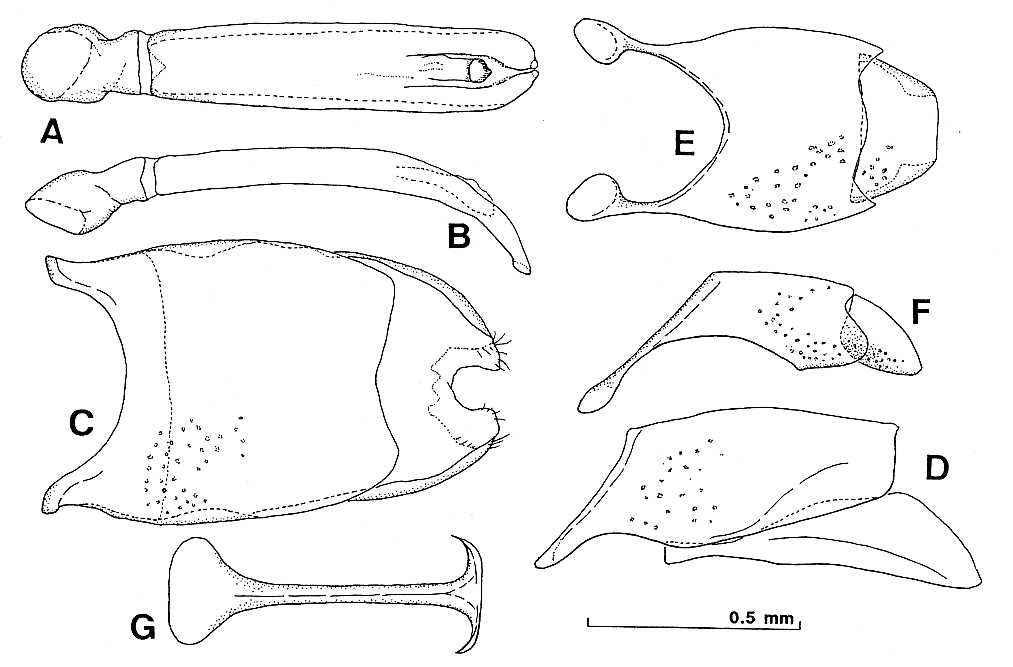
Saprinus sinae Marseul, 1862: 496, fig. 52 [China: Shang-Hai]; Blackburne, 1903: 106; Jkobson, 1911: 651.
Hypocaccus sinae: Desbordes, 1919: 415; Reichadt, 1941: 307, 312, fig. 158.
Hypocaccus (Hypocaccus) sinae: Kryzhanovskij and Reichardt, 1976: 226.
Japanese name: Nise-hamabe-emma-mushi.
Hypocaccus (Hypocaccus) sinae: Ôhara, 1994, 250.
Saprinus sinae Marseul, 1862, 496.
Hypocaccus (Hypocaccus) sinae: Ohara, 1994, 250; ESK & KSAE, 1994, 136 [Korea].
Description (Ohara, 1994).
Body length, PPL, 2.39 - 3.34 mm (2.90 ± 0.06, n=20), PEL, 2.22 - 2.94 mm (2.58 ± 0.05, n=20). Width, 1.86 - 2.45 mm (2.15 ± 0.03, n=20). Biometric data are given in Table 50. Body oval and moderately convex. Cuticles very strongly shining and black or nearly so with strong bronzy or brassy lustre; antennae dark rufopiceous with club rufotestaceous; legs dark reddish brown.
Frontal stria of head (Fig. 142C) carinate, complete and straight on each side. Supraorbital stria well impressed. Disk of front impunctate, with two or three transverse rugae, which are sometimes interrupted. Epistoma scabrose.
Pronotal sides (Fig. 130C) rather feebly arcuate and not strongly convergent on basal four-fifths, thence strongly arcuate and convergent to apices. Apical angles somewhat round. Marginal stria complete and carinate. Disk smooth, its sides strongly, densely and moderately punctate anteriorly, the punctate area sometimes becoming broader basally and the punctures coarser and more rugose in the region of the anterior angles. Basal margin of pronotum with one or two rows of large punctures, which, however, become finer laterally.
Epipleura of elytra impunctate and even. Marginal epipleural stria complete. Marginal elytral stria deeply impressed and complete, its apical end extending along the posterior margin of elytron and united with the apical end of sutural stria at medio-apical angle of elytron. External subhumeral stria absent. Internal subhumeral stria shortly present on medial third. Oblique humeral stria well impressed on basal third to half, close to, and parallel with the 1st dorsal stria. First dorsal stria deeply impressed, crenate and present on basal two-thirds. Second, 3rd and 4th dorsal striae well impressed and coarsely punctate; these striae a little longer than the 1st. Sutural stria represented by a fine, crenulate, complete line, the apical end united with marginal elytral stria and the basal end united with the 4th in an arch. Surface of elytra smooth, impunctate on basal half, coarsely and densely punctate on apical half, the punctures being separated by their own diameter to half the diameter; extreme apex of elytra (around apical stria) and flanks impunctate.
Propygidium densely and moderately punctate, the punctures being separated by slightly more than their diameter. Pygidium sparsely and moderately punctate, the punctures becoming denser towards basal angles, and finer and sparser apically; apex of pygidium impunctate.
Anterior margin of median portion of prosternum (Fig. 141C) round. Preapical foveae distinctly present. Keel moderately compressed, its anterior apex narrowly truncate. Descending lateral striae carinate and convergent to apex. Carinal striae usually present on basal three-fourths, and usually parallel apically and divergent basally, sometimes their apical ends united with each other at middle of keel. Lateral side of keel sparsely (sometimes densely) covered with coarse punctures on apical half, with fine punctures intermingled.
Anterior margin of mesosternum feebly emarginate, its marginal stria carinate and complete. Disk smooth, sparsely clothed with microscopic punctures. Meso-metasternal suture finely impressed, accompanied with a parallel coarsely crenated line. Intercoxal disk of metasternum smooth except in a transverse apical band, which is sparsely and coarsely punctate. Lateral metasternal stria well impressed, extending obliquely and posteriorly, reaching near hind coxa. Lateral disk sparsely covered with large punctures, with fine ones intermingled. Disk of metasternum densely covered with moderate punctures.
Intercoxal disk of 1st abdominal sternum completely striate on each side, and moderately punctate along the apical and basal margins, the punctures becoming denser at anterior corners.
Protibia with 6 large spinules on outer margin.
Male genitalia as shown in Fig. 145.
Table 50. Biometeric data of Hypocaccus sinae (Marseul).
---------------------------------------------------------------------
APW 0.75-0.98 (0.86±0.01) 20
PPW 1.57-2.22 (1.95±0.04) 20
PL 0.85-1.14 (1.04±0.02) 20
EL 1.31-1.83 (1.54±0.03) 20
EW 1.86-2.45 (2.15±0.03) 20
ProW 1.14-1.57 (1.33±0.02) 20
ProL 0.33-0.46 (0.39±0.01) 20
PyL 1.14-1.62 (1.30±0.03) 20
PTL 0.65-0.88 (0.76±0.01) 20
MSTL 0.62-0.92 (0.74±0.02) 20
MTTL 0.69-0.98 (0.82±0.02) 20
-----------------------------------------------------------------------
Remarks. Hypocaccus sinae superficially resembles H. (Baeckmanniolus) varinans, but can be distinguished from the latter by the characters given in the key.
This species occurs on sandy beach. It is occasionally found also on the sandy beach of mountain rivers (Kurosawa, 1988).

[Hokkaidô] 1 ex., Sakanoshita, Wakkanai, 10/viii/1974, Y. Kusui leg.; 6 exs., Kitahama, Abashiri, 10/vii/1958, T. Nakane leg. (NA); 7 exs., Zenibako, 24/vi/1954, T. Kumata leg. (EIHU); 1 ex., Ditto, 21/vi/1985, M. Ôhara leg.; 1 ex., Momigi-yama, Ishikari, 1/vi/1974, S. Kudô leg. <Okushiri Is.> 2ÅâÅâ, 1 ex., Aonae, 28/vi/1986, Y. Kusui leg.
[Honshû] <Yamagata-ken> 1 ex., Miyaumi, Yamagata, 28/v/1953, K. Shirahara leg. (NA). <Ibaraki-ken> 2 exs., Tone River, Kwachi vill., 10/x/985, M. Kiuchi leg. <Chiba-ken> 2 exs., Iwai, Bôsô-hantô, 23/viii/1966, Y. Kusui leg.; 2 exs., Okitsu, v/1913, F. Muir leg. (BSM). <Niigata-ken> 12 exs., Niigata-shi, 5/v/1933, K. Baba leg. (NA). <Ishikawa-ken> 4 exs., Uchida-sakyû, 31/viii/1968, H. Ebihara leg. <Ôsaka-fu> 3 exs., Yodo River, 31/x/1954, T. Shibata leg. (NA). <Hyôgo-ken> 2 exs., Hiraiso, 14/viii/1954, T. Shibata leg. (NA). <Wakayama-ken> 1 ex., Minabe, 17/iii/1942, K. Sakaguchi leg. (NA).
[Kyûshû] <Fukuoka-ken> 1 ex., Hakozaki, 1/ix/1964, F. Nakasuji leg. (NA). <Kagsohima-ken> 1 exs., Fukiage, 29/vii/1984, M. Ôhara leg.
Korea: Cheju-do: Chung-mun, 24/vii/1993 (1 ex., J.-C. Paik).
Japan: [Hokkaido] Proper: Momiji-yama, Ishikari (1 ex., 1/vi/1974), S. Kudo; Zenibako, Otaru (1 ex., 21/v/1985), M. Ohara.
[Honshu] Chiba-ken: Kazusanomiya (1 ex., 7/v/1976), S. Morita; Kidohama, Hikari-chô (2 exs., 12/xi/1986, CBM-Z-61425, 27), T. Itoh; Kimigahama, Choshi-shi (3 exs., 26/iv/1971, CBM-Z-53936-7, 41), H. Yamazaki. Aichi-ken: Hosoya, Omotehama, Toyohashi (4 exs., 21/v; 2 exs., 11/vi/1990), M. Hasegawa (Hasegawa & Kanie, 1992). Shiga-ken: Biwako-han, Hikone (4 exs., 1/vi/1991), S. Shiyake; Hikone (1 ex., 16/vi; 1 ex., 14/viii/1992), S. Shiyake. Wakayama-ken: Mihama, Enjugahama (17 exs., 29/v/1991), S. Shiyake.
[Kyushu] Kagoshima-ken: Fukiage (1 ex., 29/vii/1984), M. Ohara.
Distribution (Fig. 147). Japan (Hokkaidô, Honshû, Shikoku, Kyûshû).
